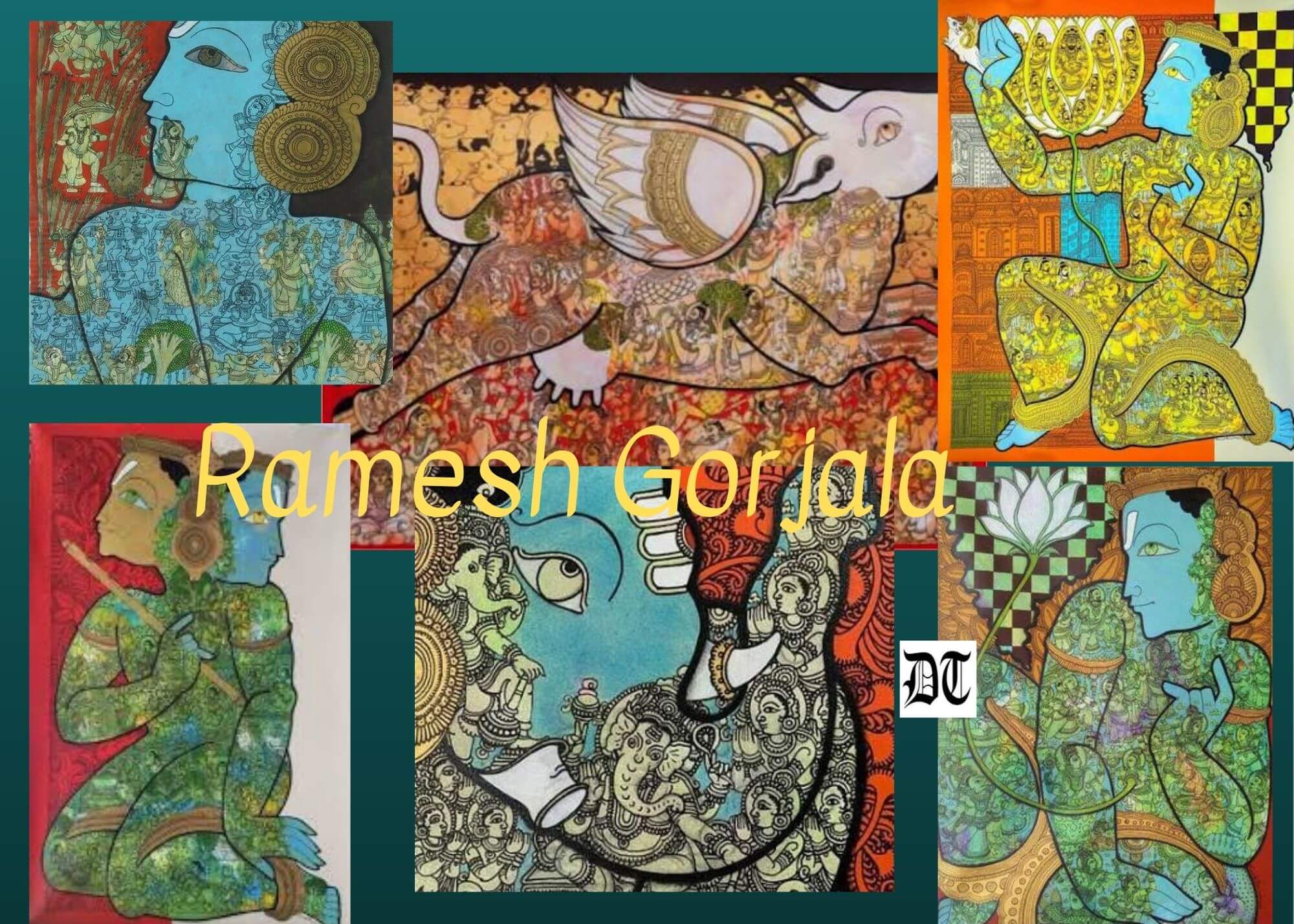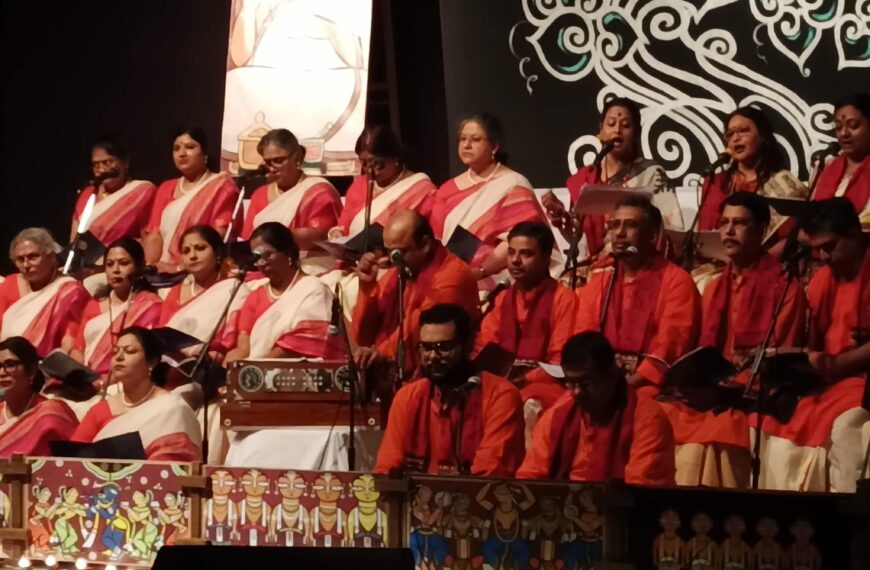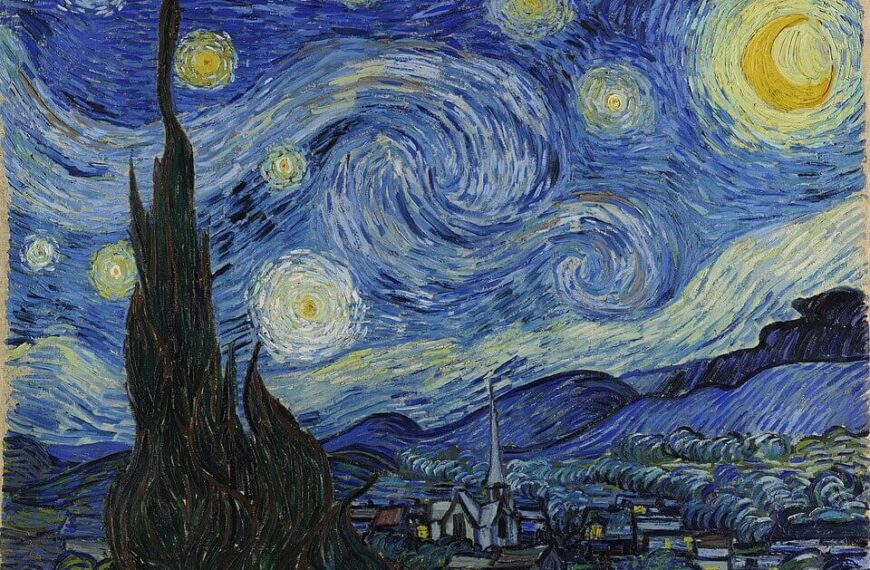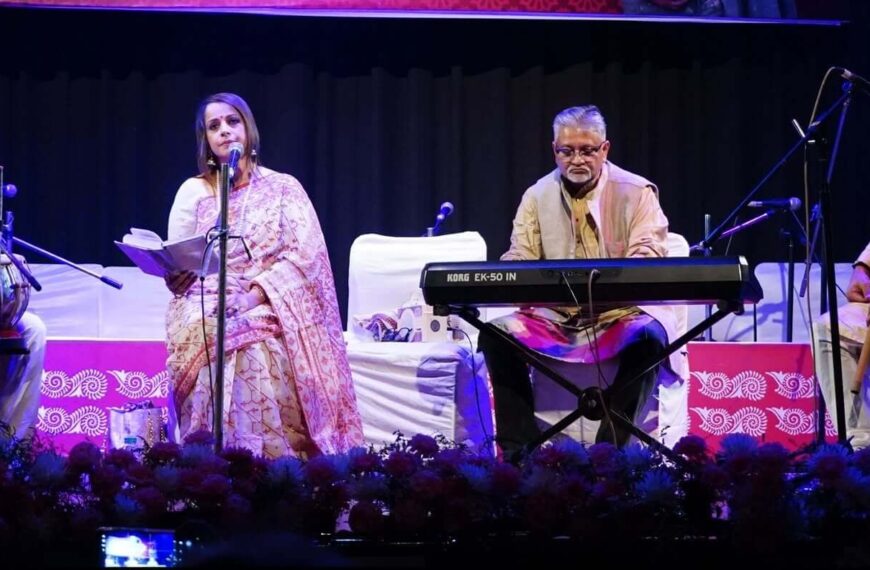Ramesh Gorjala, a Kalamkari artist’s evocative artworks not only displays the scenes of a narrative but brilliantly encapsulates the theme of the painting, says Monika. An exclusive for Different Truths.
Storytelling is an eloquent technique to put forward a purpose or a notion but depicting it through a visual art or performing art, is an onerous yet exhilarating experience. Telling a story or narrating the different aspects of an epic through fine arts is a challenging thing to do. It takes an imaginative acumen of highest order.
The type of art that narrates a story from history, literature, religion, mythology, etc., is termed as narrative art. Although we find some common features to all narrative art, yet worldwide different cultures and heritage have developed individualistic ways to discern narrative art.
The type of art that narrates a story from history, literature, religion, mythology, etc., is termed as narrative art. Although we find some common features to all narrative art, yet worldwide different cultures and heritage have developed individualistic ways to discern narrative art. Art lovers and critics are aware of the timeline of Western art which till the twentieth century has been narrative. Indian School of Miniature Paintings since 10th Century AD also represented narrative art. The famous miniature painting genre depicts themes and stories from court episodes, life anecdotes, love, and hunting scenes, and war chronicles.
“The principles of true art’s not to portray, but to evoke,” said Scott Adams.
That is exactly what artist Ramesh Gorjala’s artworks remind us of. His art not only displays the scenes but brilliantly encapsulates the theme of the painting.
Gorjala, a modern contemporary artist from Andhra Pradesh has kept the heritage of narrative art alive in India. His unique ‘eclectic style’ emphasises on religious and mythological portrayals of Indian heritage and history.
Gorjala, a modern contemporary artist from Andhra Pradesh has kept the heritage of narrative art alive in India. His unique ‘eclectic style’ emphasises on religious and mythological portrayals of Indian heritage and history. Eclecticism is a kind of mixed style in the fine arts: “the borrowing of a variety of styles from different sources and combining them” (Hume 1998, 5). The term describes the combination in a single work of a variety of influences—mainly of constituents from different historical styles in painting.

A lot of efforts, thoughts, and creativity is necessary in order to make an artwork, in an eclectic style, look logically interconnected.
Gorjala’s paintings use the body of one dominant character, preferably a deity or a persona from mythology or history in a ‘figurative’ art form. Within this figure, he creates sketches, weaving a story or a saga in a unique Kalamkari pattern defining the main character or protagonist figure. Kalamkari is an ancient Indian type of hand printing or hand block printing with delicate detailing, mostly on cotton textile using natural dyes with a tamarind pen (Kalam).
Elements are thoughtfully connected with the other parts of the style in the space.
Colours, texture, and the medium tend to be neutral to further help these different influences come together and avoid the chaotic look with the other features of the painting.
Gorjala’s artworks are uniquely insightful. An elaborated visual representation of mythological or historical legends in and around the focal figurative character. So, we get imagery of allegorical art infused with symbolic art. An unequalled portrayal of a static figure along with a dynamic recital. A critical analysis of his art form reveals the prevalence of composite art form too.
Gorjala’s artworks are uniquely insightful. An elaborated visual representation of mythological or historical legends in and around the focal figurative character. So, we get imagery of allegorical art infused with symbolic art. An unequalled portrayal of a static figure along with a dynamic recital. A critical analysis of his art form reveals the prevalence of composite art form too.
His visual portrayals are mostly the continuous narrative. It is a type of narrative that elucidates the multiple scenes of a narrative within a single frame. Multiple actions, sequences, and scenes are depicted in a single visual field without any partitioning. The sequence of events within the narrative is explicated through the reuse of the main character or protagonist.
His imaginative use of palette concocts well with the theme of the artwork. The hues chosen carefully, create a vibrant and lively scene in his paintings. The spectacle that he exudes is chronicled yet contemporary. The central character predominantly are deities and legends of Indian or Indian subcontinent regions.

His imaginative use of palette concocts well with the theme of the artwork. The hues chosen carefully, create a vibrant and lively scene in his paintings. The spectacle that he exudes is chronicled yet contemporary. The central characters predominantly are deities and legends of Indian or Indian subcontinent regions. The portrayals are spiritually and conceptually enriching.
The intricate detailing done in a distinctive Kalamkari pattern is surely a magnificent feature in Gorjala’s paintings. The beauty of his artworks lies in the unique amalgamation of subject matter and the character. We have come across the Mythological stories on paintings and sculpting on the walls of temples and cave monuments. Gorjala has kept the art alive in his own peculiar way.
The aspects of composite art are indeed the apogee in Gorjala’s depictions. His creative art dismisses limitations and embraces novel ways of storytelling.
The scene depictions are not only done by interposing images but also by snippets of texts. The checkerboard pattern enhanced by monochromatic hues adds a dramatic tinge to his paintings, enhancing the narrative intent of the paintings. The aspects of composite art are indeed the apogee in Gorjala’s depictions. His creative art dismisses limitations and embraces novel ways of storytelling.
Gajrola was born in Srikalahasti, Andhra Pradesh, in 1979. He has done BFA in Painting from the JNTU, Hyderabad. He belongs to the family of weavers and being inspired by his National Award (in Kalamkari) winning uncle, Sh. Balaji Teertham took to the unique presentation of arts. The traditional Kalamkari / hand-printed craft was the legacy that lived on through his ancestors. It was his uncle who motivated him to pursue this traditional technique through visual demonstration.
His art accents the Indian heritage and culture through unique visual lore. This unique presentation adds a novelty and curiosity element to spectators.

Artist Ramesh Gorjala 
Artist Ramesh Gorjala 
Artist Ramesh Gorjala 
Artist Ramesh Gorjala
His art accents the Indian heritage and culture through unique visual lore. This unique presentation adds a novelty and curiosity element to spectators. Ramesh Gorjala’s work has won him state-of-the-art awards, including the Mahatma Gandhi Birth Centenary Memorial Award from the V.T.I., Chennai in 2000, and the State Award from the A.P. Crafts Council in 2002.
The artist has participated in solo as well as many group exhibitions in India and abroad. His solo displays include ‘Mythological Metaphor’ at Chawla Art Gallery, New Delhi, in 2010; ‘Embracing Modernity’ at Mon Art Gallerie, Kolkata, in 2007. He also had his show at Tao Art Gallery, Mumbai, and in the ‘Art in Action’ exhibition held in London.
There are few exceptional contemporary artists in India who have been able to make an impression and Gorjala’s art portrayal through a unique composite style has made an indelible mark in the art world.
Visuals sourced by the author and by Different Truths
Artist Ramesh Gorjala






 By
By
 By
By
 By
By